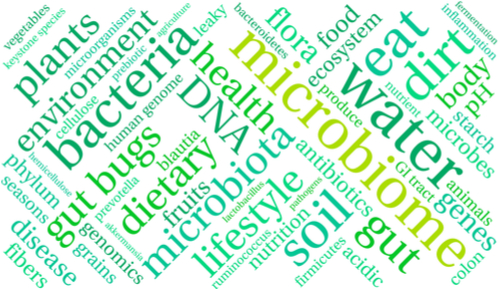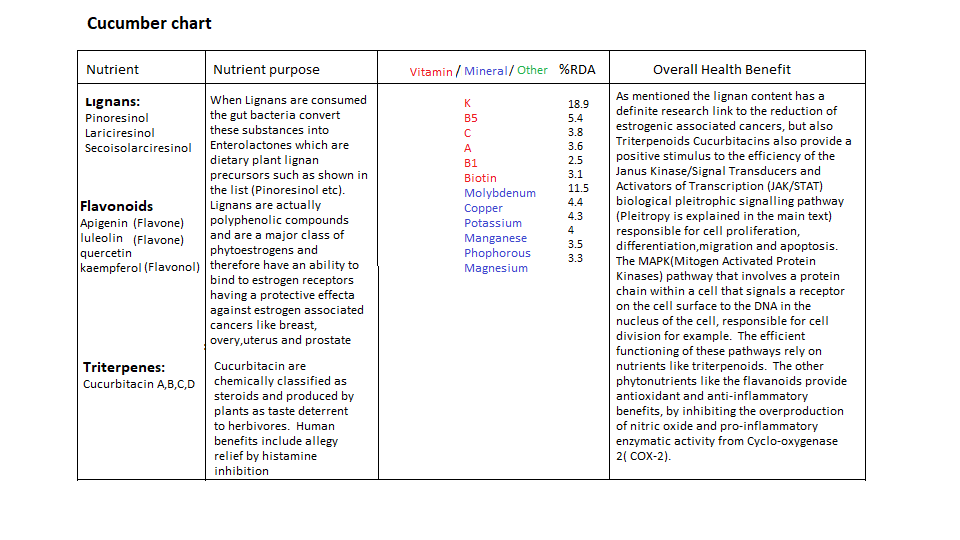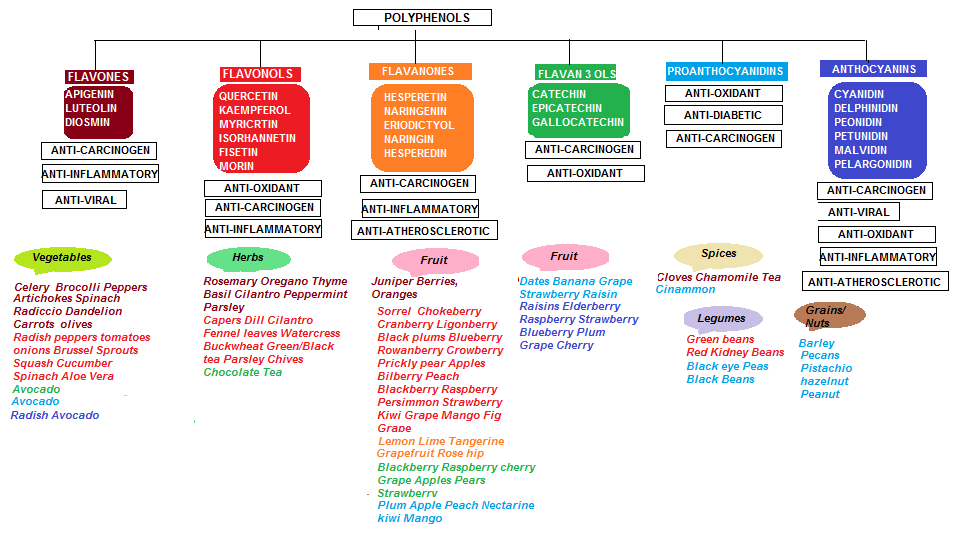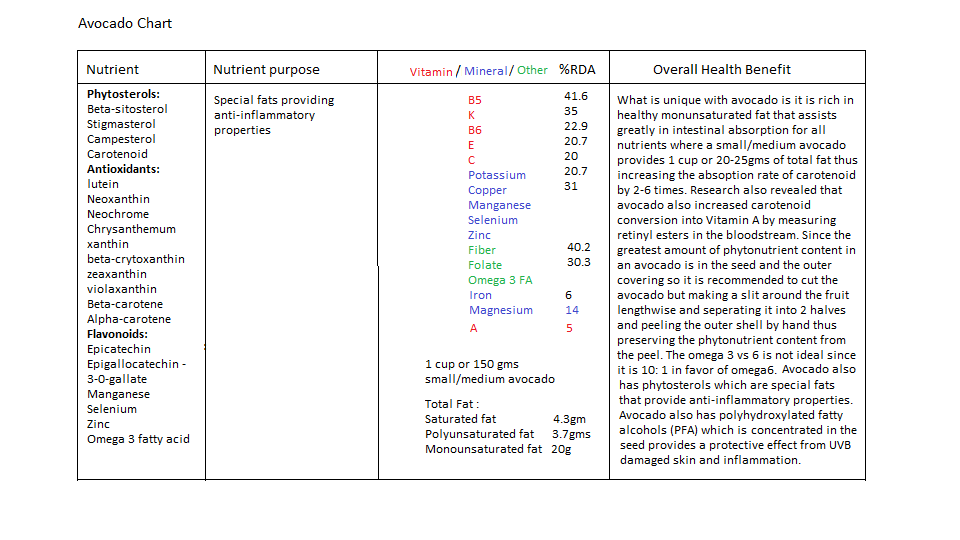Featured foods : Cucumber,Avocado
Introduction
As we progress through this series of articles you will begin to appreciate that it’s not just the Vitamin/Mineral content of plants that provides us with the essential nutrients of life, but the mechanisms that are produced by various plants used to sustain their own survival, providing humans with additional benefits that are in some instances are converted by our own bacterial ecosystem. In the previous article we discussed phenols, which we will expand a little in this second article and discuss Lignans, Triterpenes, Phytosterols, Carotenoids and Fatty acids.
Microbiota and plant compounds

To further our discussions of phenolic compounds let us look at the involvement of our microbiota with these plant derived dietary substances. One particular phenolic sub family are the flavonoids that are further divided into flavanones, flavones, dihydroflavonols, flavonols, flavan-3-ols, anthocyanidins, isoflavones and proanthocyanidins. The non flavonoid families of phenols are simple phenols, phenolic acids, benzoic aldehydes, hydrolysable tannins, acetophenones and phenyl acetic acids, hydroxycinnamic acids, coumarins, benzophenones, xanthones, stilbenes, lignans and secoiridoids. Whenever any of these phenolic substances are consumed a small % ranging between 5-10% of the total is absorbed in the gut (small intestine), but the lion’s share 90-95% accumulate in the intestinal lumen ( biologically not absorbed into the body and the bloodstream so it is outside of the body). Consequently the majority of phenolic compounds end up in the colon where the colonic microbiota which is more dense than anywhere in the body *, convert them into bacterial metabolites increasing bioavailability to the host, down regulating pathogenic bacteria and up regulating beneficial bacteria. Phenols such as lignans and flavonoids contain glucuronic acid which is a small sugar that bacteria scavenge as a source of carbon when they metabolise phenolic substances, using an enzyme beta-glucuronidase producing aglycones. However it is the O-Glycosides in the flavonoids that are actually converted into aglycones by the bowel flora. For example Naringin, a flavonoid glycoside that is abundant in the skin of grapefruit and oranges, but its Naringenin, the aglycone that is synthesized by the shikimate pathway of the bacterial colonies.
The 5-10% of phenolic flavones that get absorbed into the body are hydrolyzed by digestive enzymes or degraded by gut bacteria to their aglycones form in the intestine which are then reduced and conjugated to form water metabolites o-glucuronides and o-sulphates in the liver. These are then released into the blood circulation targeting organs that will benefit from these products. It must be noted here that lipids or fat enhance bioavailability of phenolic substances, but proteins and dietary fiber tend to decrease bioavailability. The importance of a healthy microbiome was shown in a study performed by Esposito et al in 2015 using a low and high fat diet with a 1% black currant ( a phenolic anthocyanin) powdered extract for 8 weeks into mice with a healthy and compromised gut flora and found the former had reduced body weight gain and improved glucose metabolism but not in the mice with compromised microbiota, who were fed prior to the study, with an antibiotic cocktail that resulted in a 16-25 fold increase in anthocyanin content in the feces. In essence the compromised gut flora caused the beneficial phenols to be excreted, and that a healthy gut microbiota had a protective effect from the black currant anthocyanins against obesity and insulin resistance. Ludwig et al in 2015 underwent a similar study using raspberries again comparing the amount of fecal excretion of the anthocyanins to the action of the colonic bacteria.
* The human gut is comprised of approximately 10 power 14 bacterial cells estimated to be 10 times that of mammalian cells. The microbial genome is estimated to contain 3 million genes, 150 times more than the 25,000 mammalian genes which clarifies the vastness of these microbiota eco colonies and its remarkable synergistic influence on the functioning biology of the host.
Flavonoids

From the cucumber chart this food contain 2 flavones, 1 flavonol and 1 flavonoid. Flavonoids are one of the largest collection of nutrients and more than 6,000 have been identified. There is evidence that these converted products as described above provide biological benefits of flavonoids that include antioxidant, antidiabetic, anti-inflammation, antifungal. antitumor, anticoagulant, antiplatelet, anti degranulating (associated with allergies), antitrypanosomal ( associated with infectious insect bites that cause Chagas and sleeping sickness for example), influenza virus neuraminidase inhibition, aldehyde oxidase inhibition, immunomodulatory, and antitubercular activity. However, O-glycosylation ( the normal carbohydrate/monosaccharide form of a flavonoid prior to conversion into aglycone form by the microbiota) can enhance certain types of biological benefits including anti-HIV activity, tyrosinase inhibition, anti rotavirus activity, antistress activity, antiobesity activity, anticholinesterase potential, anti adipogenic activity, and antiallergic activity.
 I have recreated a polyphenol chart that was featured in the articles on the 90 essential nutrients
I have recreated a polyphenol chart that was featured in the articles on the 90 essential nutrients

Triterpenes

These compounds have been found to benefit the human body as anti-inflammatories, antimicrobials, anti-carcinogens and antivirals. Since they are steroid precursors they assist in the natural steroid production such as cortisol, an anti-inflammatory steroid hormone. Although there are many triterpenes that exist in nature, one food that is rich in powerful triterpenoids is the reishi mushroom, but cucumber contains its own, Triterpenes also possess a balancing property for hormones assisting in digestion, the immune system, nervous system blood pressure and circulation, and liver health. In 2016 3 researchers Gill BS et al studied triterpene substances in cancer and found that triterpenes target cellular membrane receptors and the inflammatory pathway Nuclear factor kappa B ( NF-kB), and the intracellular signalling pathway P13K/AKT/mTOR that regulates the cell cycle focusing mostly on apoptosis ( cancer cell death).
Triterpenes and Pleiotropy
Pleiotropy refers to a gene that once expressed at a genetic level, can change multiple traits at the phenotypic level (Observable traits or characteristics of an individual). This is an ideal base for conventional scientists to attempt to uncover mutagenic genes so their research is already bias with preconception. One example is Marfan’s syndrome, and individuals with this abnormality who typically are tall and thin, with long arms, fingers and toes, flexible joints, scoliosis, and possibly eye lens dislocation, and a bulge in the aorta of the heart. The diagnosis is based on a preconceived notion relating to a genetic disorder that determines the amount ( or lack thereof of fibrils storage shelves) of Fibrillin, a protein that is associated with connective tissue, as opposed to possibly a nutrient deficiency of the mother. The phenomena of pleiotropy occurs naturally in plants as Mendel discovered in his plant experiments discovering white flowers, but their seed coats and axil were colorless, and purple flowers, but their seed coats were brown gray and the axil was reddish ( The axil is the angle of a branch from the stalk). Myotonic dystrophy, muscular dystrophy * and sickle cell anemia are other examples that rely on the pleiotropic signalling pathway such as JAK/STAT that involves an interactive chain of proteins in a cell communicating information from outside of the cell to the cell nucleus activating gene transcription.
* In 2011 Dr Joel Wallach had successively reversed Muscular dystrophy in several children using diet and the 90 essential nutrient supplement with extra selenium Jerry Lewis who was the host for the Muscular dystrophy Association (MDA) Labor day telethon going back to the 60’s was contacted via his personal assistant,Violet and made aware of this discovery. Lewis very excited with the news brought it to the attention of the medical committee of the MD association. Soon after it was announced that the 2011 Labor day Telethon would be the last featuring Jerry Lewis. According to Wikipedia the press release was ambiguous not specifying if he resigned or he was dismissed, and Lewis stated that the controversy was too difficult to get into. It seemed apparent that the medical committee did not want to know this, so according to Wallach, Lewis was removed from his position as host and chairman, but you can be the judge of what transpired…coincidence perhaps.
Polyphenol content and loss

As we stated before, most, if not all, foods contain some phenolic content, where the outer layers contain the most dense, while in the inner parts contain less. The actual content depends upon the degree of ripeness at the time of harvest, the particular environmental conditions such as soil type, sun exposure, rainfall, processing and storage. Phenolic acid diminishes during ripening, but anthocyanin content increases. Phenolic acid within the plant is a healing agent by lignification to repair damage due to various forms of stress. We spoke earlier about storage concerning the protection against natural oxidation. Cooking of course has a major effect on food concerning phenolic content such as onions and tomatoes that lose around 80% of their initial quercetin content after a 15 min boil, 65% in a microwave and 30% after frying, but of course most readers do not use these types of food preparations…lol.
Finally if we look at the unique properties of the avocado described in the chart below:

Phytosterols/Cholesterol

As cholesterol is to humans, phytosterol is to plants. Let us discuss a little about cholesterol , since for most people this substance is still a demon in our bodies and believe that we must get rid of it at all costs, and we must block the liver from making it. This string of nonsense is a hand-me-down from the companies that want to sell drugs to interfere with cholesterol manufacture within the human body and they have managed to convince prescribing physicians to distribute cholesterol lowering drugs sometimes without diagnosis but based on age. Cholesterol levels in the body vary daily just like blood pressure, depending on the bodies requirements, and as I have said before cholesterol does not cause clogged arteries, they repair arteries. At any snapshot in time cholesterol can measure between 105 mg/dl (milligrams/decilitre) or 2.8 mmol/l ( millimoles/litre) to 343 mg/dl (8.8mmol/l) irregardless if you are healthy or unhealthy, or if you had a heart attack ot not had a heart attack, A study published in the Lancet involving 5,574 patients from Australia and New Zealand who had already suffered a heart attack were measured with average cholesterol levels of 220 mg/dl (5.7 mmol/l) which was the same value as the general population that hadn’t had a heart attack. Generally, plants use predominantly sitosterol and stigmasterol for membrane structure in the same way as in mammalian cells, and also phytosterols are used by plants to help adapt to temperature fluctuations and immunity against pathogens. There is evidence going back to the 50s that human ingested plant phytosterols have cholesterol lowering effects but this is controversial because phytosterols in their natural form are insoluble so attempts to study their effects are contradictory. The food companies have attempted to overcome this problem by esterification using long chain fatty acids to increase solubility in margarine and vegetables oils which are high in phytosterols, but they also happen to be in liquid fats, although both products should be avoided anyway. Furthermore, eating foods like avocado that contain phytosterols that exist naturally in the fruit may have some effect on cholesterol but in concert with the bodies needs and the natural regulatory control of the cholesterol manufacturing mechanism of the liver, the body is perfectly capable of utilizing these substances without mans intervention with drugs and other schemes.
Carotenoids

More importantly the antioxidant power of avocados should be addressed. The predominate carotenoid that resides in the pulp is Chrysanthemum Xanthin alongside neoxanthin,trans neoxanthin, neochrome, Lutein, beta and alpha carotene. Carotenoids serve two main purposes in plants and algae, to absorb light energy for photosynthesis and to protect chlorophyll ( the blood of the plant) from UVA/UVB sun damage. However, carotenoids play a role in cell signalling by the production of a plant hormone abscisic acid responsible for regulating plant growth, seed dormancy, embryo maturation, germination, cell division, floral growth and stress response. Carotenoids are actually derived from tetraterpenes which are organic pigments ( substances that change color from wavelength selective absorption) and are responsible for color changes in leaves during autumn (fall) for some tree species. There are some 1100 known carotenoids which absorb light wavelengths of 400-550 nanometres ( UVA violet-green in the light spectrum).
Plant carotenoids differ in terms of light wavelengths they absorb, and what they reflect. Two carotenoids in avocado Lutein and Zeaxanthin contain oxygen and are referred to as Xanthophylls ( normally coloured yellow), while non oxygenated carotenoids such as alpha, beta carotene and lycopene ( as in tomatoes) are known as carotenes ( normally colored red/orange ). The colors of carrots,corn,canaries,daffodils, egg yolks, rutabagas (swede), buttercups, bananas, apricots are due to carotenoid contents. Even bacteria such as Staphylococcus aureus uses a carotenoid staphyloxanthin to protect itself from the reactive oxygen species used by the host immune system. A ketone carotenoid Astaxanthin is contained in appreciable amounts in Krill a small crustacean that uses astaxanthin to protect itself from UV sunlight by turning its body red. Any other sea organism that consume the krill like shrimp, salmon and lobster also turn red because of the consumed carotenoid. The Krill itself consume algae to acquire this carotenoid and a health food supplement Krill oil is advisable to use to provide some protection from UV sunlight as opposed to an exogenous poisonous synthetic sunscreen.
Carotenoid health benefits
Lutein and Zeaxanthin have the ability to block blue light from reaching the underlying structure of the retina in the eye reducing the risk of light induced oxidative damage leading to macular degeneration( MD). It may also be stated other nutrients are required to prevent this condition*
*Dr Wallach relates a story in his book epigenetics during a talk on the 90 essential nutrients where he claimed that taking these nutrients daily can prevent and even reverse macular degeneration to eliminate the buildup of ‘ceroid lipofuscin’ a free radical pigment damage to the retina. During the talk a Dr Ronald Pugh stood up and called Wallach a liar and said that MD was caused by old age and there was no way of preventing or curing it. Wallach then said if you give me 12 of your MD patients that have been legally blind for 8-10 years and if I restore their sight and are then able to read 20/20 in 90 days would you be willing to apologize. Hell yes replied Dr Pugh, if you can achieve that with 2 I will apologize. The next day Pugh brought 27 medical records and Wallach set to work by giving all 27 the 90 essential nutrients for 90 days and all except 2 who needed glasses had their sight restored. Pugh kept his word a recorded a formal apology and burnt it on a CD entitling it ‘Seeing is believing’.
The ‘skinny’ on fat

From our avocado chart the fat content consists of Saturated fat, Polyunsaturated fat and Monounsaturated fat. Below are molecular models of the 3 types of fat. The double bonds referred to in the diagrams are the number of kinks in the molecular chain, so saturated fat has none, monounsaturated fat has one, and polyunsaturated fat has more than one. So what ? you may ask, well the more double bonds or kinks the more unstable the oil is when coming into contact with light,heat and oxygen. Coconut oil is almost 90% saturated fat which is why it is a very stable fat to cook with and less likely to become unstable with light or oxygen. Butter is a good cooking oil but it can burn easily because it is made up of only 60% saturated fat and the other 40% is a mixture of mono and polyunsaturated fat. Olive oil is 70% oleic acid, a monounsaturated fat which is more stable than say soybean oil which is 60% polyunsaturated fat, but olive oil has an added protection since it contains polyphenols and tocopherols that provide antioxidant capabilities. This is evident if you store olive oil in a cold environment when it begins to get cloudy, which is a consequence of antioxidicity. This property also buffers against acidity. Fat products in general is another subject altogether since it entails lipid hypothesis and demonized cholesterol as we have mentioned earlier. In terms of fat we need to avoid oxidation since this can cause an inflammatory response within the body, but in terms of natural foods like avocado it is one of nature’s perfect foods containing healthy fats, vitamins.minerals, fibre, phytosterols, antioxidants and flavonoids. So avoid people who are lipid hypothesis possessed believing that avocados are unhealthy because they contain a lot of fat that clog arteries and cause heart attacks.



“The only way to keep your health is to eat what you don’t want, drink what you don’t like, and do what you’d rather not.” ~Mark Twain
Check out other Articles in this series:
Nutrients in Food and their bodily purpose I (Phenols)
Nutrients in Food and their bodily purpose III (Phenolic acids, sulphur, sulphides,sulphoxides )
Nutrients in Food and their bodily purpose IV (Glucosinolates, Sulforaphane, Indole-3-Carbinol)
Nutrients in Food and their bodily purpose V (Lipid distribution, absorbed fats, Criciferous Veg)
Nutrients in Food and their bodily purpose VI (Nutrients required for Liver Detox)
Nutrients in Food and their bodily purpose VII (Seeds & the Omega Fatty Acids)
Nutrients in Food and their bodily purpose VIII (Nutrients required for cellular energy production)
Nutrients in Food and their bodily purpose IX (Water I Properties and Body fluids)
Nutrients in Food and their bodily purpose X (Water II Cellular Hydration)
Nutrients in Food and their bodily purpose XI (Water III Fluid filtration, reabsorption, excretion)
Nutrients in Food and their bodily purpose XII (Water IV Blood pressure, Blood volume regulation)
Nutrients in Food and their bodily purpose XIII (Water V Body Fluid Dysfunction
Nutrients in Food and their bodily purpose XIV (Dental Nutrients)
Nutrients in Food and their bodily purpose XV (Nutrients involved in Methylation I)
Nutrients in Food and their bodily purpose XVI (Nutrients involved in Methylation II)
Nutrients in Food and their bodily purpose XVII (Nutrients involved in Methylation III)
Nutrients in Food and their bodily purpose XVIII (Nutrients involved in Methylation IV)
Nutrients in Food and their bodily purpose XIX (Methylation V and the Microbiota I)
Nutrients in Food and their bodily purpose XX (Methylation VI and the Microbiota II)
Nutrients in Food and their bodily purpose XXI (Superfoods: Wheatgrass)
Nutrients in Food and their bodily purpose XXII (Superfoods: Adaptogens)
Nutrients in Food and their bodily purpose XXIII (A look into our nutritional past Sir Robert McCarrison)
Nutrients in Food and their bodily purpose XXIV (Pregnancy: Nature vs Nurture vs Nutrition)
References/Acknowledgments :
- JAK/STAT signalling pathways, pleiotropy, P13K/AKT/mTOR pathway, The Jerry Lewis MDA Labor day telethon, Phytosterols Wikipedia
- Flavonoid glycosides Science Direct
- Dietary flavonoid aglycones and their glycosides:which show better biological significance Xiao.J 2017 NCBI
- The reciprocal Interactions between polyphenols and Gut microbiota and effects on Bioaccessibility Tugba Ozdal et al Nutrients 2015/2016
- Triterpenes in cancer : significance and their influence 2016 Gill BS et al NCBI
- The magic of Reishi revealed :Triterpenes 2016 Brianna Hyperion Herbs
- Pleiotropy and lethal alleles Khan Academy
- Epigenetics Joel Wallach, Ma Lan and Gerhard Schrauzer book 2014
- Plant polyphenols as dietary antioxidants in human health & disease 2009 Kanti Bhooshan Pandey & Syed Ibrahim Rizvi NCBI
- Creating the high cholesterol myth – why your cholesterol level is normal and not high Justin Smith 2016 Statin nation
- The 50 best quotes about health and nutrition Global Healing center
Author: Eric Malouin